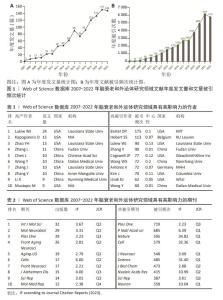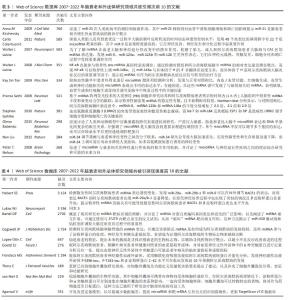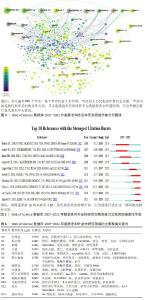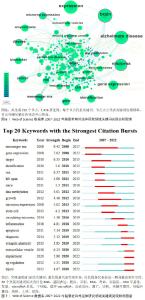[1] MATTSON MP, ARUMUGAM TV. Hallmarks of Brain Aging: Adaptive and Pathological Modification by Metabolic States. Cell Metab. 2018;27(6):1176-1199.
[2] 原新.全球人口负增长时间可能提前至2065年[J].人口与健康,2020(11):13-16.
[3] BARCO A, BAILEY CH, KANDEL ER. Common molecular mechanisms in explicit and implicit memory. J Neurochem. 2006;97(6): 1520-1533.
[4] KALAMAKIS G, BRÜNE D, RAVICHANDRAN S, et al. Quiescence Modulates Stem Cell Maintenance and Regenerative Capacity in the Aging Brain. Cell. 2019;176(6): 1407-1419.e14.
[5] HOU Y, DAN X, BABBAR M, et al. Ageing as a risk factor for neurodegenerative disease. Nat Rev Neurol. 2019;15(10):565-581.
[6] CARDOSO AL, FERNANDES A, AGUILAR-PIMENTEL JA, et al. Towards frailty biomarkers: Candidates from genes and pathways regulated in aging and age-related diseases. Ageing Res Rev. 2018;47:214-277.
[7] WANG H, LAUTRUP S, CAPONIO D, et al. DNA Damage-Induced Neurodegeneration in Accelerated Ageing and Alzheimer’s Disease. Int J Mol Sci. 2021;22(13):6748.
[8] MARKAKI M, TAVERNARAKIS N. Mitochondrial turnover and homeostasis in ageing and neurodegeneration. FEBS Lett. 2020; 594(15):2370-2379.
[9] HIPP MS, KASTURI P, HARTL FU. The proteostasis network and its decline in ageing. Nat Rev Mol Cell Biol. 2019;20(7): 421-435.
[10] SUZANNE M, STELLER H. Shaping organisms with apoptosis. Cell Death Differ. 2013; 20(5):669-675.
[11] SHIMONI O, SHI B, ADLARD PA, et al. Delivery of Fluorescent Nanoparticles to the Brain. J Mol Neurosci. 2016;60(3):405-409.
[12] DE PIETRI TONELLI D, PULVERS JN, HAFFNER C, et al. miRNAs are essential for survival and differentiation of newborn neurons but not for expansion of neural progenitors during early neurogenesis in the mouse embryonic neocortex. Development. 2008;135(23):3911-3921.
[13] KENNERDELL JR, LIU N, BONINI NM. MiR-34 inhibits polycomb repressive complex 2 to modulate chaperone expression and promote healthy brain aging. Nat Commun. 2018;9(1):4188.
[14] KENNERDELL JR, LIU N, BONINI NM. MiR-34 inhibits polycomb repressive complex 2 to modulate chaperone expression and promote healthy brain aging. Nat Commun. 2018;9(1):4188.
[15] CHEN C. Science Mapping: A Systematic Review of the Literature. J Data Inf Sci. 2017;2(2):1-40.
[16] 侯剑华,胡志刚.CiteSpace软件应用研究的回顾与展望[J].现代情报,2013,33(4): 99-103.
[17] 陈挺,李国鹏,王小梅.优化科学知识图谱方法绘制全领域科学结构图谱[J].图书情报工作,2022,66(21):107-119.
[18] SYNNESTVEDT MB, CHEN C, HOLMES JH. CiteSpace II: visualization and knowledge discovery in bibliographic databases. AMIA Annu Symp Proc. 2005;2005:724-728.
[19] 王东浩.文献计量学在图书情报与科技情报中的应用——评《文献计量学》(第二版)[J].领导科学,2022(10):153.
[20] CHEN B, SHIN S. Bibliometric Analysis on Research Trend of Accidental Falls in Older Adults by Using Citespace-Focused on Web of Science Core Collection (2010-2020). Int J Environ Res Public Health. 2021; 18(4):1663.
[21] ZHOU W, KOU A, CHEN J, et al. A retrospective analysis with bibliometric of energy security in 2000-2017. Energy Reports. 2018;4:724-732.
[22] ZHAO Y, JABER V, ALEXANDROV PN, et al. microRNA-Based Biomarkers in Alzheimer’s Disease (AD). Front Neurosci. 2020;14:585432.
[23] JABER VR, ZHAO Y, SHARFMAN NM, et al. Addressing Alzheimer’s Disease (AD) Neuropathology Using Anti-microRNA (AM) Strategies. Mol Neurobiol. 2019;56(12): 8101-8108.
[24] WANG X, ZHOU Y, GAO Q, et al. The Role of Exosomal microRNAs and Oxidative Stress in Neurodegenerative Diseases. Oxid Med Cell Longev. 2020;2020:3232869.
[25] HUBER CC, WANG H. Pathogenic and therapeutic role of exosomes in neurodegenerative disorders. Neural Regen Res. 2024;19(1):75-79.
[26] LUKIW WJ. Micro-RNA speciation in fetal, adult and Alzheimer’s disease hippocampus. Neuroreport. 2007;18(3):297-300.
[27] LUKIW WJ. MicroRNA (miRNA) Complexity in Alzheimer’s Disease (AD). Biology (Basel). 2023;12(6):788.
[28] POGUE AI, LUKIW WJ. microRNA-146a-5p, Neurotropic Viral Infection and Prion Disease (PrD). Int J Mol Sci. 2021;22(17): 9198.
[29] HALLACLI E, KAYATEKIN C, NAZEEN S, et al. The Parkinson’s disease protein alpha-synuclein is a modulator of processing bodies and mRNA stability. Cell. 2022; 185(12):2035-2056.e33.
[30] EISEN TJ, LI JJ, BARTEL DP. The interplay between translational efficiency, poly(A) tails, microRNAs, and neuronal activation. RNA. 2022;28(6):808-831.
[31] JIANG Y, LIU J, CHEN L, et al. Serum secreted miR-137-containing exosomes affects oxidative stress of neurons by regulating OXR1 in Parkinson’s disease. Brain Res. 2019;1722:146331.
[32] ZHU H, XIE R, LIU X, et al. MicroRNA-494 improves functional recovery and inhibits apoptosis by modulating PTEN/AKT/mTOR pathway in rats after spinal cord injury. Biomed Pharmacother. 2017;92:879-887.
[33] LI D, HUANG S, ZHU J, et al. Exosomes from MiR-21-5p-Increased Neurons Play a Role in Neuroprotection by Suppressing Rab11a-Mediated Neuronal Autophagy In Vitro After Traumatic Brain Injury. Med Sci Monit. 2019;25:1871-1885.
[34] YUAN FY, ZHANG MX, SHI YH, et al. Bone marrow stromal cells-derived exosomes target DAB2IP to induce microglial cell autophagy, a new strategy for neural stem cell transplantation in brain injury. Exp Ther Med. 2020;20(3):2752-2764.
[35] NAKANO M, KUBOTA K, KOBAYASHI E, et al. Bone marrow-derived mesenchymal stem cells improve cognitive impairment in an Alzheimer’s disease model by increasing the expression of microRNA-146a in hippocampus. Sci Rep. 2020;10(1):10772.
[36] ROKAVEC M, LI H, JIANG L, HERMEKING H. The p53/miR-34 axis in development and disease. J Mol Cell Biol. 2014;6(3):214-230.
[37] HUANG Y, DRIEDONKS TAP, CHENG L, et al. Brain Tissue-Derived Extracellular Vesicles in Alzheimer’s Disease Display Altered Key Protein Levels Including Cell Type-Specific Markers. J Alzheimers Dis. 2022;90(3): 1057-1072.
[38] MCKEEVER PM, SCHNEIDER R, TAGHDIRI F, et al. MicroRNA Expression Levels Are Altered in the Cerebrospinal Fluid of Patients with Young-Onset Alzheimer’s Disease. Mol Neurobiol. 2018;55(12): 8826-8841.
[39] BADER AG. miR-34 -a microRNA replacement therapy is headed to the clinic. Front Genet. 2012;3:120. |











